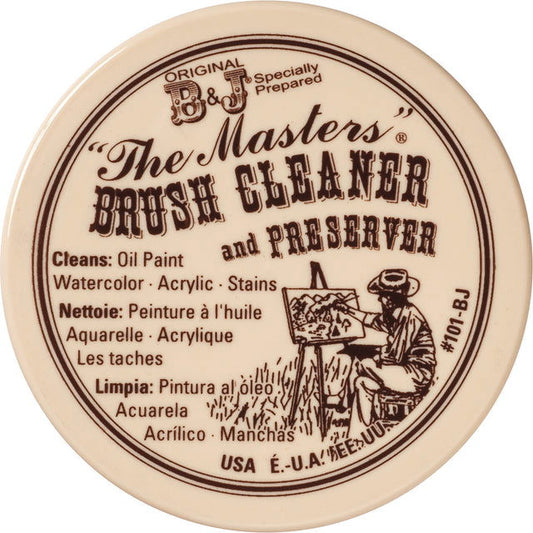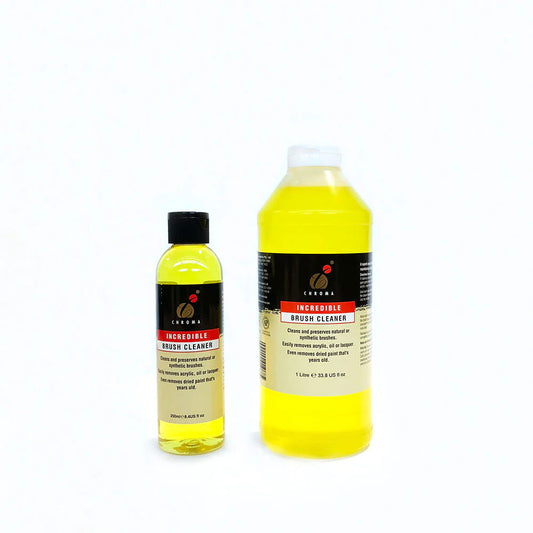
How to Clean Paintbrushes
Share
Learn how to properly clean synthetic and natural hair paintbrushes to extend their lifespan and keep them in top shape.
Cleaning your paintbrushes properly is essential if you want them to last. But did you know that different types of brushes—synthetic and natural hair (like sable or hog bristle)—need different cleaning methods?
If you’ve ever wondered whether you should be scrubbing your synthetic brushes the same way you treat your delicate sable ones, you’re in the right place. Here’s everything you need to know about keeping your brushes in top shape!
Do Synthetic and Natural Hair Paintbrushes Need Different Cleaning Methods?
Yes! The type of hair on your brush determines how you should clean it. Synthetic brushes are generally tougher and can handle harsher cleaning agents, while natural hair brushes require a gentler approach to maintain their softness and longevity.
Cleaning Synthetic Paintbrushes
Synthetic brushes (made from nylon or polyester) are durable and easier to clean than natural ones. They’re commonly used with acrylics, watercolours, and oils.
Cleaning Acrylic & Watercolour Paint from Synthetic Brushes
- Rinse the brush immediately after painting—dried acrylic can be tough to remove.
- Use lukewarm water (not hot!) and mild soap or brush cleaner to wash out the paint.
- Swirl the bristles gently in your palm to work out any residue.
- Rinse thoroughly and reshape the bristles before letting the brush dry flat or upright.
Cleaning Oil Paint from Synthetic Brushes
- Wipe off excess paint with a rag or paper towel first.
- Rinse the brush in a solvent like odourless mineral spirits or a dedicated brush cleaner.
- Follow up with soap and water to remove any lingering residue.
- Reshape the bristles and let the brush dry completely.
Pro Tip: Avoid scrubbing synthetic brushes too hard, as it can fray the bristles over time.
Cleaning Natural Hair Paintbrushes (Sable, Hog, Squirrel, etc.)
Natural hair brushes are softer and more absorbent, making them ideal for delicate applications like watercolours and oils. However, they require extra care to prevent damage.
Cleaning Watercolour Paint from Natural Hair Brushes
- Rinse the brush in clean, lukewarm water immediately after use.
- Swirl the bristles in a mild brush soap (avoid harsh detergents).
- Gently reshape the bristles and let the brush dry naturally.
Cleaning Oil Paint from Natural Hair Brushes
- Wipe off excess paint with a cloth.
- Rinse the brush in a solvent like odourless mineral spirits, being careful not to soak the entire brush (this can loosen the glue holding the bristles).
- Wash with a conditioning soap or brush cleaner and lukewarm water.
- Reshape the bristles and let the brush dry horizontally or with the bristles facing down.
Additional Notes for Frequent Oil Painters
- Skip the Full Wash (Sometimes): If you paint regularly (weekly or more), you don’t always need to break out the soap and water. Simply wipe off excess paint and swish your brushes in solvent, saving the thorough clean for when you’re taking a longer break.
- Wrap or Freeze: For daily painters, try wrapping your wiped brushes in cling wrap or even storing them in the freezer. This way, they’ll be ready to go the next day without a complete wash in between sessions.
- Linseed Oil Dip: Some artists keep a shallow, sloping tray filled with linseed oil and immerse their brushes (without standing them upright) to prevent paint from drying.
- Brush Cleaner Caution: While brush cleaner is fantastic at dissolving paint, be sure to rinse it out thoroughly to keep your bristles in top condition.
Key Differences in Cleaning Synthetic vs Natural Brushes
| Feature | Synthetic Brushes | Natural Hair Brushes |
|---|---|---|
| Durability | Tougher, withstand stronger cleaners | Delicate, require gentle cleaning |
| Absorption | Less absorbent | Hold more pigment & water |
| Acrylic Paint Use | Great for acrylics | Not recommended for acrylics |
| Oil Paint Cleaning | Can handle solvents | Needs conditioning to prevent drying |
| Maintenance | Rinse & store upright | Requires occasional conditioning |
Final Tips for Keeping Your Paintbrushes in Top Condition
- Never leave brushes sitting in water or solvent for long periods—it can warp the bristles and loosen the ferrule.
- Always reshape your brushes after washing to maintain their original form.
- For natural hair brushes, occasionally condition them with a drop of hair conditioner to keep them soft.
- Store brushes properly—upright in a holder or flat in a brush case.
By taking care of your brushes properly, you’ll extend their lifespan and keep them performing beautifully for years to come.













